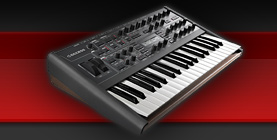

|
|||||||
| Sound designing Discussion about sound designing with the Virus series synths. Share patches and your knowledge or ask questions. |
 |
|
|
Thread Tools | Search this Thread | Display Modes |
|
#1
|
||||
|
||||
|
This is a technique called a lissajous. (look it up, if you really care) I see it as a symmetrical representaion of the sound as it happens. The virus unison function must pop the sound out of phase, 90 degrees, thus forming these brilliant and incredibly organic shapes.
http://www.youtube.com/watch?v=Q_kYHBsfPxc Anyhow, let's see a one voiced anal log do this. Ha! Maybe if it's fed through the virus. (Analog through the virus filters sounds amazing, btw) |
|
#2
|
||||
|
||||
|
I actually have an old oscilloscope, how do you hook it up?
Lissajous figures are generated with a stereo signal only so not sure how to hook it up. I regularly use the lissajous scope in Wavelab to see if any high frequencies are starting to clip (the display starts to look like a diamond) before the problem becomes audible. HF clipping sounds horrible and saps the dynamic life out of any audio, so I try and avoid it like the plague. Unfortunately many mastering houses these days don't, and their stuff sounds like utter shite. The loudness wars and all that. Tons of commercial stuff (and I'm talking original rips of prime-time pop acts) suffer irreparable damage by over compression which is easily visible on the scope.
__________________
PS > And another thing! Will the Ti|3 have user customisable/importable wavetables? |
|
#3
|
||||
|
||||
|
Great video.. how did you make this? Is this a software represenation, or you are filming a hardware oscilloscope? Would love to make a music clip with a synth patch represented in this fashion.
__________________
Lilt (electronic/vocal project) - www.soundcloud.com/lilt-aus feedingear (experimental, video and film game scoring, dance, artist interviews) www.soundcloud.com/feedingear Soundfield Studio (recording, mixing, mastering) http://www.soundfieldstudio.com/ |
|
#4
|
|||
|
|||
|
hey...is it true that if the lissajous figure is a horizontal line, then the signal is 180 degrees out of phase....and then that sort of out of phase signal can cause dropouts/cancellations on some music/audio systems or when switched to mono ?
i was under the impression that i should completely avoid such out of phase recordings or signals...i have also avoided using any stereo widening plugins etc because of this....is there a way to work around this ?? i'm a little confused about this..... please elaborate... thanks |
|
#5
|
||||
|
||||
|
Quote:
The usual "stereo widening" algorithm takes a copy of the left channel, inverts it, then sums it with the right channel, whilst at the same time takes a copy of the original right channel, inverts it, and adds it to the left channel. In otherwords it's making both channels more out of phase with each other, by erasing any common ground they have in the 'phantom' centre channnel. You can still use a touch of stereo widening (a small wetness) for the benefit of those who are going to hear it in stereo, but not too much of it otherwise it'd start erasing some of the audio signal if played in mono. It's a compromise. There are many other ways of being able to increase stereo widening without losing mono compatibility. Chorus, double-tracking, using different instruments playing the same part but panned hard left and hard right respectively, adding reverb, using complementary EQing of both channels of a stereo signal, or even more creative stuff like splitting the signal to M&S format (middle and side) and processing the side-channel before converting the M&S signal back to L&R ... all these things will be summed together when made mono, so although you'll lose the panorama you wont lose any of the audible signal. However the result might sound like there's too much happening when it's all summed to mono as you have so many things going on and now they step on each others toes, overcrowding all of the headroom making it sound busy and muddy, so making a good mix is a compromise between sounding good in stereo whilst still sounding good when merged to mono. Most studios have a mono button on a mixer or similar that you can press to quickly hear what it'll sound like in mono while it's playing back just to keep a check on things.
__________________
PS > And another thing! Will the Ti|3 have user customisable/importable wavetables? |
|
#6
|
|||
|
|||
|
Thanks Timo for the detailed, informative reply.....
|
|
#7
|
|||
|
|||
|
i had some more questions about this....but i forgot...so as soon as i remember..i will post on here again..
|
 |
«
Previous Thread
|
Next Thread
»
| Thread Tools | Search this Thread |
| Display Modes | |
|
|
All times are GMT. The time now is 07:46 AM.
Powered by vBulletin® Version 3.6.4
Copyright ©2000 - 2025, Jelsoft Enterprises Ltd.
Skin Designed by: Talk vBulletin
Copyright ©2000 - 2025, Jelsoft Enterprises Ltd.
Skin Designed by: Talk vBulletin
Copyright ©2002-2022, Infekted.org
 |
 |









 Linear Mode
Linear Mode

